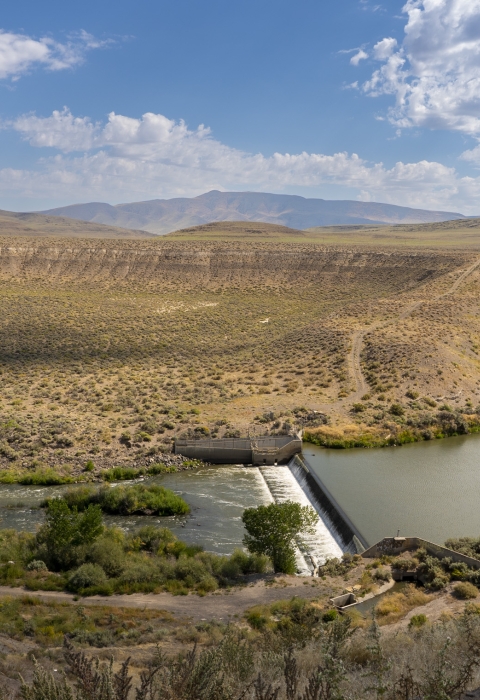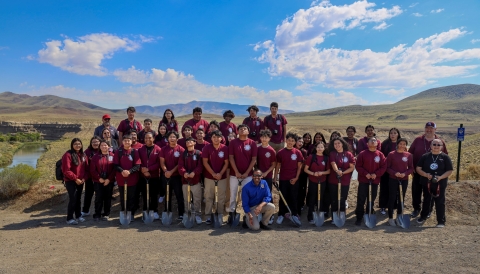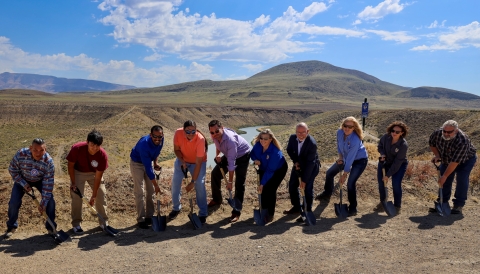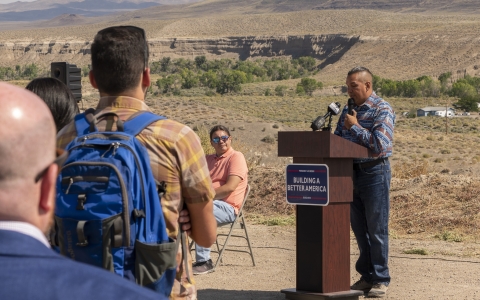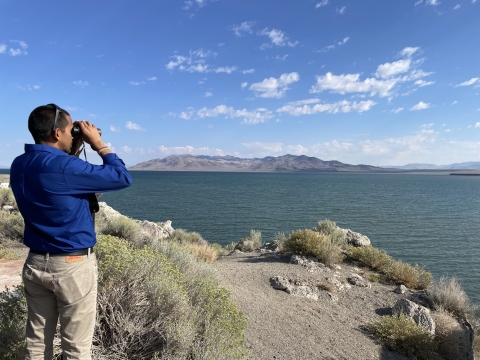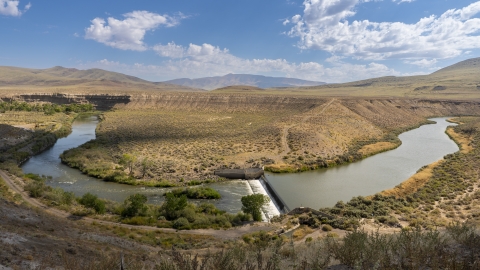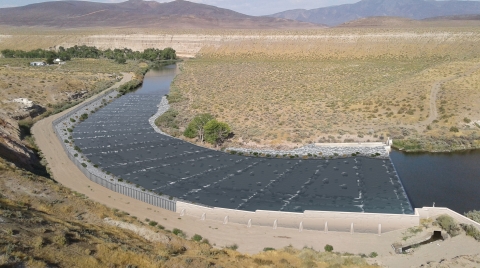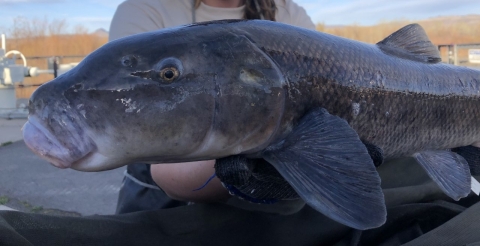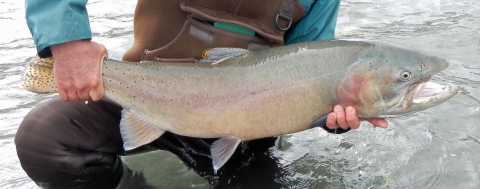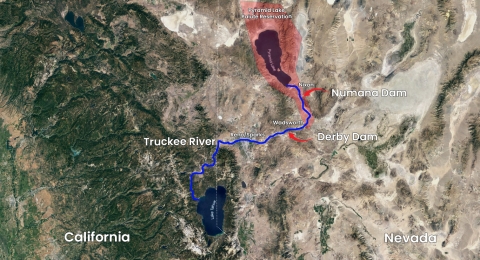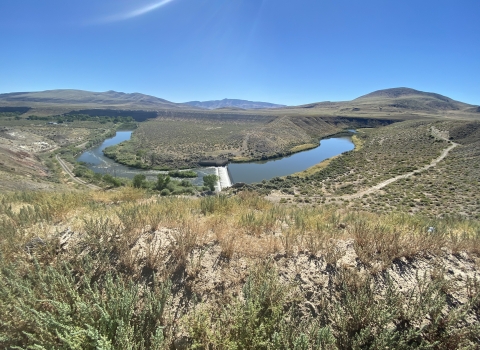On September 13, the Pyramid Lake Paiute Tribe and U.S. Fish and Wildlife Service broke ground to commence construction on a fish passage project at Numana Dam in northern Nevada. Bureau of Indian Affairs, Bureau of Reclamation, Nevada Department of Wildlife and other partners joined the Service and the Tribe onsite to celebrate this project and what it signifies for the recovery of the Cui-ui sucker and the Lahontan cutthroat trout.
A once-in-a-generation investment opportunity
In 2022, the Service awarded the Pyramid Lake Paiute Tribe almost $8.3 million in Bipartisan Infrastructure Law funding to support the Tribe’s vision of removing an in-stream migration barrier at Numana Dam. The Bipartisan Infrastructure Law Bipartisan Infrastructure Law
The Bipartisan Infrastructure Law (BIL) is a once-in-a-generation investment in the nation’s infrastructure and economic competitiveness. We were directly appropriated $455 million over five years in BIL funds for programs related to the President’s America the Beautiful initiative.
Learn more about Bipartisan Infrastructure Law provided $455 million to the U.S. Fish and Wildlife Service to be distributed across five programs.
The largest amount, $200 million over five years, was provided to the National Fish Passage Program, the only national scale program to receive Service Bipartisan Infrastructure Law funding. This funding more than tripled the annual amount of funding available for fish passage fish passage
Fish passage is the ability of fish or other aquatic species to move freely throughout their life to find food, reproduce, and complete their natural migration cycles. Millions of barriers to fish passage across the country are fragmenting habitat and leading to species declines. The U.S. Fish and Wildlife Service's National Fish Passage Program is working to reconnect watersheds to benefit both wildlife and people.
Learn more about fish passage projects under the program. The huge increase in funding allowed the program to target projects that were previously unattainable, like the fish passage project at Numana Dam.
Partnering with the Pyramid Lake Paiute Tribe
The installation of a permanent fish passage structure structure
Something temporarily or permanently constructed, built, or placed; and constructed of natural or manufactured parts including, but not limited to, a building, shed, cabin, porch, bridge, walkway, stair steps, sign, landing, platform, dock, rack, fence, telecommunication device, antennae, fish cleaning table, satellite dish/mount, or well head.
Learn more about structure at Numana Dam will benefit two federally listed species, the Lahontan cutthroat trout (Oncorhynchus clarkii henshawi) and Cui-ui sucker (Chasmistes cujus). Both species hold cultural significance to the Pyramid Lake Paiute Tribe. The Tribe has supported modification to Numana Dam for over two decades to aid in the recovery of these federally listed fish.
Decades of recovery efforts have been made possible by a longstanding partnership between the Pyramid Lake Paiute Tribe, the U.S. Fish and Wildlife Service, Bureau of Indian Affairs, Bureau of Reclamation, Nevada Department of Wildlife and others. The momentum of this partnership paved the way for securing nearly $8.3 million Bipartisan Infrastructure Law funding in 2022.
A word from the Tribal Chairman
“The Pyramid Lake Paiute Tribe is excited to implement another project to reverse centuries of obstacles to fish spawning in the lower Truckee River,” said Pyramid Lake Paiute Tribal Chairman James Phoenix.
“This project will allow both the endangered Cui-ui and threatened Lahontan cutthroat trout, each of which is culturally and spiritually important to the members of the Pyramid Lake Paiute Tribe, to once again access their historic spawning areas on and upstream of the Tribe’s reservation. On behalf of the Tribe, I want to sincerely thank our federal partners for helping to make this much-needed project a reality.”
A word from the Service’s Deputy Director
“President Biden’s Investing in America agenda is making historic investments to restore our nations lands and waters, protect fish and wildlife and advance local communities and economies,” said Deputy Director Sundaresan.
“We’re thrilled to break ground on this important project today which showcases the Department’s dedication to investing in conservation efforts that are inclusive, collaborative, locally led and honor Tribal sovereignty.”
Addressing a more than 100-year-old barrier to fish migration
Numana Dam is an irrigation diversion structure within the boundary of the Pyramid Lake Paiute Reservation and provides irrigation water to the Pyramid Lake Paiute Tribal farmers and ranchers. This structure has been in place since 1917 and, in its present form, has been a significant passage barrier for the Cui-ui sucker and Lahontan cutthroat trout. The species have been negatively impacted by water infrastructure and land use changes over the last century, including the installation of dams.
Enhancing fish migration along the Truckee River at Numana Dam
Retrofitting Numana Dam with a roughened ramp structure across the width of the river will open an additional 65 miles of habitat along the Truckee River from Pyramid Lake for the endangered Cui-ui sucker and the threatened Lahontan cutthroat trout. Access to this habitat is essential for the recovery of the species in the wild. The ramp will be approximately 1,000 feet in length and will be constructed of rocks. The ramp will include steps and pools to allow for gentle migration downstream and resting habitat for fish migrating upstream.
A brief history of the Cui-ui sucker
Cui-ui were federally listed as endangered on March 11, 1967, under the Endangered Species Preservation Act of 1966. Cui-ui are a large, robust, lacustrine sucker endemic to ancient Lake Lahontan, which covered much of northwest and west-central Nevada. Currently, Cui-ui spend the majority of their time in Pyramid Lake except when they use the lower portion of the Truckee River for spawning.
Cui-ui depend on Pyramid Lake for rearing habitat and the lower Truckee River for spawning habitat. They are only able to access their spawning habitat when hydrologic conditions are suitable. Studies have reported water temperatures between 9 and 17 degrees Celsius (48.2 to 62.6 degrees Fahrenheit) during the migration with adult Cui-ui demonstrating a preference for gravel and cobble substrate for spawning.
A brief history of the Lahontan cutthroat trout
Lahontan cutthroat trout were listed by the Service on October 13, 1970, as endangered and reclassified as threatened on July 16, 1975, under the Endangered Species Act. Less than 10 percent of their historical habitat is currently occupied range wide, which includes the Truckee River and Pyramid Lake.
The Lahontan cutthroat trout is one of 13 living sub-species of cutthroat trout. This fish is native to the Lahontan Basin of northern Nevada, northeastern California and southeastern Oregon. This subspecies exhibits three life histories including: stream-type, migratory and lacustrine forms. These fish inhabit freshwater lakes, rivers and streams, and feed primarily on aquatic insects, crustaceans, small fishes and floating plant matter.
Paving the way for the restoration of the Truckee River Basin
In 2022, Bureau of Reclamation completed a $35 million project to construct a fish screen at Derby Dam, a historic spawning habitat upstream. The Derby Dam Fish Passage Project allows operation of a fishway that connects the lower Truckee River at Numana Dam to 65 miles of Lahontan cutthroat trout spawning habitat. The reestablishment of the iconic native strain of Lahontan cutthroat trout in the Truckee River basin has garnered continued support from the Pyramid Lake Paiute Tribe, Bureau of Reclamation, Bureau of Indian Affairs, Nevada Department of Wildlife, the angling community and local elected officials.
